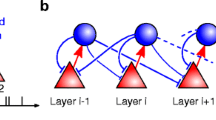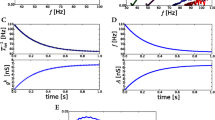Abstract
We investigate the effect on synchrony of adding feedback loops and adaptation to a large class of feedforward networks. We obtain relatively complete results on synchrony for identical cell networks with additive input structure and feedback from the final to the initial layer of the network. These results extend the previous work on synchrony in feedforward networks by Aguiar et al. (Chaos 27:013103, 2017). We also describe additive and multiplicative adaptation schemes that are synchrony preserving and briefly comment on dynamical protocols for running the feedforward network that relates to unsupervised learning in neural nets and neuroscience.













Similar content being viewed by others
Notes
In dynamical systems theory, there are methods based on the Taken’s embedding theorem (Takens 1981) that allow reconstruction of complex dynamical systems from time-series data. However, these techniques seem not to be useful in data processing.
References
Aguiar, M.A.D., Dias, A.: The lattice of synchrony subspaces of a coupled cell network: characterization and computation algorithm. J. Nonlinear Sci. 24(6), 949–996 (2014)
Aguiar, M.A.D., Dias, A., Ferreira, F.: Patterns of synchrony for feed-forward and auto-regulation feed-forward neural networks. Chaos 27, 013103 (2017)
Aguiar, M.A.D., Dias, A., Field, M.J.: Bifurcation, dynamics and feedback for adaptive feed-forward networks (2018) (in preparation)
Ashwin, P., Rodrigues, A.: Hopf normal form with \(S_N\) symmetry and reduction to systems of nonlinearly coupled phase oscillators. Phys. D: Nonlinear Phenom. 325, 14–24 (2016)
Ashwin, P., Swift, J.W.: The dynamics of n weakly coupled identical oscillators. J. Nonlinear Sci. 2(1), 69–108 (1992)
Belykh, V., Hasler, M.: Mesoscale and clusters of synchrony in networks of bursting neurons. Chaos 18, 016106 (2011)
Bick, C., Field, M.J.: Asynchronous networks and event driven dynamics. Nonlinearity 30(2), 558–594 (2017)
Bick, C., Field, M.J.: Asynchronous networks: modularization of dynamics theorem. Nonlinearity 30(2), 595–621 (2017)
Bick, C., Field, M.J.: Functional asynchronous networks: factorization of dynamics and function (MATEC Web of Conferences, 83 (2016), CSNDD 2016—International Conference on Structural Nonlinear Dynamics and Diagnosis, Marrakech, May 23–25) (2016)
Bishop, C.M.: Neural Networks for Pattern Recognition. Oxford University Press, Oxford (1995)
Caporale, N., Dan, Y.: Spike timing dependent plasticity: a Hebbian learning rule. Annu. Rev. Neurosci. 31, 25–36 (2008)
Chandra, S., Hathcock, D., Crain, K., Antonsen, T.M., Girvan, M., Ott, E.: Modeling the network dynamics of pulse-coupled neurons. Chaos 27(3), 033102 (2017)
Davey, B.A., Priestley, H.A.: Introduction to Lattices and Order. Cambridge University Press, Cambridge (1990)
Ermentrout, G.B., Kopell, N.: Parabolic bursting in an excitable system coupled with a slow oscillation. SIAM J. Appl. Math. 46, 233–253 (1986)
Field, M.J.: Heteroclinic networks in homogeneous and heterogeneous identical cell systems. J. Nonlinear Sci. 25(3), 779–813 (2015)
Gerstner, W., Kempter, R., van Hemmen, L.J., Wagner, H.: A neuronal learning rule for sub-millisecond temporal coding. Nature 383, 76–78 (1996)
Fricker, D., Miles, R.: EPSP amplification and the precision of spike timing in hippocampal neurons. Neuron 28, 559–569 (2000)
Goedeke, S., Diesmann, M.: The mechanism of synchronization in feed-forward neuronal networks. New J. Phys. 10, 015007 (2008)
Golubitsky, M., Postlethwaite, C.: Feed-forward networks, center manifolds, and forcing. Disc. Cont. Dyn. Sys. Ser. A 14(2), 2913–2935 (2012)
Golubitsky, M., Schaeffer, D.G., Stewart, I.N.: Singularities and Groups in Bifurcation Theory, Vol. II. Appl. Math. Sci. 69. Springer, New York (1988)
Golubitsky, M., Stewart, I.: Nonlinear dynamics of networks: the groupoid formalism. Bull. Am. Math. Soc. 43, 305–364 (2006)
Golubitsky, M., Stewart, I., Törok, A.: Patterns of synchrony in coupled cell networks with multiple arrows. SIAM J. Appl. Dyn. Syst. 4(1), 78–100 (2005)
Goodfellow, I., Bengio, Y., Courville, A.: Deep Learning. MIT Press, Cambridge (2017)
Hadley, B.: Pattern Recognition and Neural Networks. Cambridge University Press, Cambridge (2007)
Hassoun, M.H.: Fundamentals of Artificial Neural Networks. MIT Press, Cambridge (1995)
Hoppensteadt, F.C., Izhikevich, E.M.: Weakly Connected Neural Networks (Applied Mathematical Science), vol. 126. Springer, Berlin (1997)
Ito, J., Kaneko, K.: Self-organized hierarchical structure in a plastic network of chaotic units. Neural Netw. 13(3), 275–281 (2000)
Ito, J., Kaneko, K.: Spontaneous structure formation in a network of chaotic units with variable connection strengths. Phys. Rev. Lett. 88(2), 028701 (2002)
Kamei, H., Cock, P.J.A.: Computation of balanced equivalence relations and their lattice for a coupled cell network. SIAM J. Appl. Dyn. Syst. 12, 352–382 (2013)
Kaneko, K.: Relevance of dynamical clustering to biological networks. Phys. D 75, 55–73 (1994)
Kuramoto, Y.: Chemical Oscillations, Waves, and Turbulence. Springer, Berlin (1984)
Lee, H.L., Padmanabhan, V., Whang, S.: Information distortion in a supply chain: the Bullwhip effect. Manag. Sci. 43(4), 546–558 (1997)
Lin, K.K., Shea-Brown, E., Young, L.-S.: Spike-time reliability of layered neural oscillator networks. J. Comput. Neurosci. 27, 135–160 (2009)
Masquelier, T., Guyonneau, R., Thorpe, S.J.: Spike timing dependent plasticity finds the start of repeating patterns in continuous spike trains. PLoS ONE 3(1), e1377 (2008)
Masquelier, T., Guyonneau, R., Thorpe, S.J.: Competitive STDP-based spike pattern learning. Neural Comput. 21(5), 1259–1276 (2009)
Masquelier, T., Hugues, E., Deco, G., Thorpe, S.J.: Oscillations, phase-of-firing-coding, and spike timing-dependent plasticity: an efficient learning scheme. J. Neurosci. 29(43), 13484–13493 (2009)
Minsky, M., Papert, S.: Perceptrons: An Introduction to Computational Geometry. MIT Press, Cambridge (1969)
Morrison, A., Diesmann, M., Gerstner, W.: Phenomenological models of synaptic plasticity based on spike timing. Biol. Cybern. 98(6), 459–478 (2008)
Panaggio, M.J., Abrams, D.M.: Chimera states: coexistence of coherence and incoherence in networks of coupled oscillators. Nonlinearity 28(3), R67 (2015)
Pedantic of Purley: Uncircling the Circle: Part I (On line article https://www.londonreconnections.com/2013/uncircling-circle-part-1/, in London Reconnections, October 3, 2013.)
Rink, B., Sanders, J.: Amplified Hopf bifurcations in feed-forward networks. SIAM J. Appl. Dyn. Syst. 12(2), 1135–1157 (2013)
Rosenblatt, F.: The perceptron: a probabilistic model for information storage and organization in the brain. Psychol. Rev. 65(6), 386–408 (1958)
Sailamul, P., Jang, J., Paik, S.-B.: Synaptic convergence regulates synchronization-dependent spike transfer in feedforward neural networks. J. Comput. Neurosci. 43, 189–202 (2017)
Schmidhuber, J.: Deep learning in neural networks: an overview. Neural Netw. 61, 85–117 (2015)
Stewart, I.: The lattice of balanced equivalence relations of a coupled cell network. Math. Proc. Camb. Philos. Soc. 143(1), 165–183 (2007)
Stewart, I., Golubitsky, M., Pivato, M.: Symmetry groupoids and patterns of synchrony in coupled cell networks. SIAM J. Appl. Dyn. Syst. 2(4), 609–646 (2003)
Takens, F.: Detecting Strange Attractors in Turbulence (Lecture Notes in Mathematics 898). Springer, Berlin (1981)
Acknowledgements
The authors acknowledge and appreciate the detailed comments of the referees which have helped improve the exposition and readability of the paper. The authors were partially supported by CMUP (UID/MAT/00144/2013), which is funded by FCT (Portugal) with national (MEC) and European structural funds through the programs FEDER, under the partnership agreement PT2020.
Author information
Authors and Affiliations
Corresponding author
Additional information
Communicated by Paul Newton.
Rights and permissions
About this article
Cite this article
Aguiar, M.A.D., Dias, A. & Field, M. Feedforward Networks: Adaptation, Feedback, and Synchrony. J Nonlinear Sci 29, 1129–1164 (2019). https://doi.org/10.1007/s00332-018-9513-7
Received:
Accepted:
Published:
Issue Date:
DOI: https://doi.org/10.1007/s00332-018-9513-7




